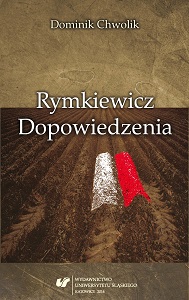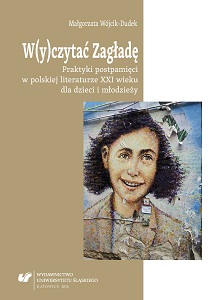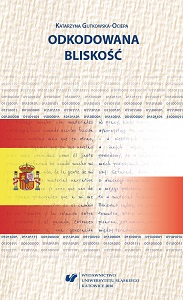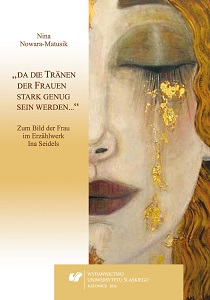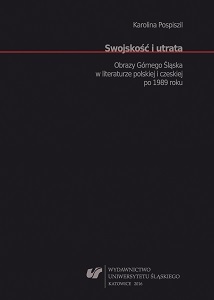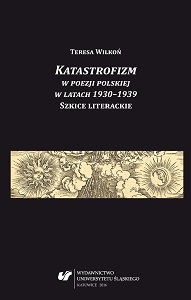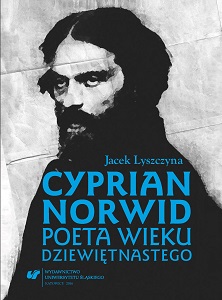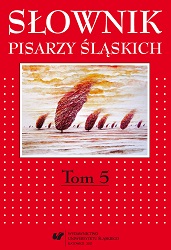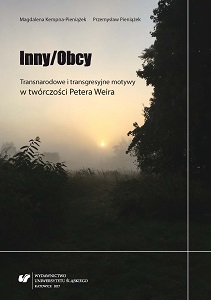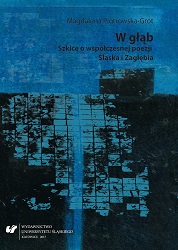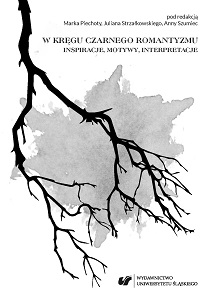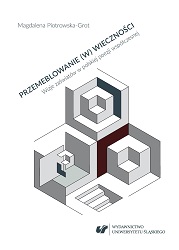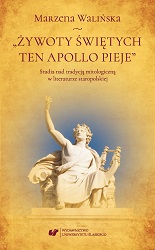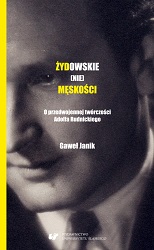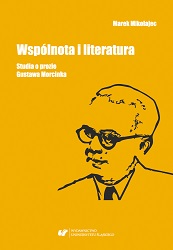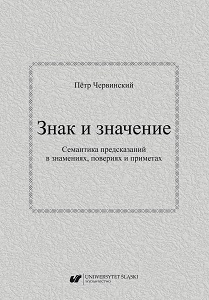Odkodowana bliskość. Powieściopisarstwo Enrique Vili-Matasa, Antonia Muñoza Moliny i Alejandra Cuevasa w kontekście prozy polskiej po 1989 roku
Author(s): Katarzyna Gutkowska-Ociepa / Language(s): Polish
Keywords: comparative; Spanish contemporary literature; Enrique Vila-Matas; Alejandro Cuevas; Antonio Muñoz Molina; Polish contemporary literature
The monograph constitutes a comparative study of selected novels published after 1989 in Spain and Poland. Instead of focusing on translation or reception issues, which are generally more popular in the case of comparative literary analysis, the study consists of a structural and problem analysis of the works of five prose writers coming from two distant cultural backgrounds. The interpretative and comparative analysis is preceded by introductory remarks concerning the state of comparative studies as a discipline of modern literary and cultural studies, focusing on American, Spanish, Polish and German theories in particular. From the very first pages, the monograph reveals itself to be a site of an ongoing struggle and shifts in the scholarly focus, ranging from the work of literature itself to various contexts (gender, sociological, cultural, political, etc.) existing outside the realm of literature, as well as the return to literature understood as the center of literary comparative studies, however tautological this statement may be. In order to find her way in the multilingual tangle of statements and contradictions, the author combines several cohesive literature-centric perspectives, which allows her to create her own methodological model, which, in turn, enables her to conduct an ordered, controlled and theoretically sound comparative analysis of selected Spanish and Polish novels. The study is based on hermeneutics and intercultural literary theory proclaimed by Norbert Mecklenburg, Mieczysław Dąbrowski’s theory of comparative studies of the discourse and the discourse of comparative studies, Andrzej Hejmej’s understanding of the interdisciplinary nature of comparative studies, as well as the idea of “open comparative studies” developed by the most prominent comparative studies scholar of the 20th century, Claudio Guillén. The aforementioned concepts were created on the basis of the idea of the autotelic nature of the work of literary fiction; due to that fact, they propose a study of literature as an aesthetically autonomic form of expression which can be related to external contexts inasmuch as it contributes to a broader interpretation of the given work of literature.
Another important context for the theoretical part of the monograph is genology, which points to the potential of the novel as the currently dominant genre, characterized by the greatest openness with regard to both the topics as well as structural potential. As a result, the novel-both Polish and Spanishis presented as not only a textual construct and genre framework, but also as a reflection of the postmodern hybrid culture, in which idealization remains in constant conflict with the esperpentic tendency for self-ridicule, and pompous pathos competes with everyday ordinariness, while literature, relegated to the popcultural peripheries, thanks to its constant use of metareflection, thrives and boasts one of its most creative periods since the end of the 19th century.
Chapters two, three, and four constitute the interpretative and analytical part of the monograph. The research material has been ordered according to the thematic similarities between the novels, which resulted in three main axes of division: the first constitutes a literary duel with the past and tradition, the second poses a challenge to the world of art (mostly painting and photography), and the third encompasses a narrative encounter with the world of culture.
The first category includes two highly intertextual novels: “Castorp” by Paweł Huelle and “París no se acaba nunca” (“Paris Has No End”) by Enrique Vila-Matas. In the case of these two authors, what is constitutive for their fiction is a particular fondness for various literary games revealing the complexity of character creation as well as multiplying the levels of autocreation, which can be seen in the overt inclusion of autobiographical or quasi-autobiographical elements into the fictional narrative. This dialogue with Nobel Prize laureates (Mann and Hemingway) in the form of a novel allows the authors to construe their creations on two levels: half-joking, half-serious. This, in turn, reflects their unique approach to the literary craft, which uses intertextuality and autothematism as a pretext for distancing oneself from taking oneself too seriously, oscillating between authenticity and mask, or even masquerade. This, in turn, allows them to add to the complexity of the fictional nature of their work and open for their readers gateways to different literary worlds created by novelists such as Fontane, Duras or Perec. Thus, both novels ultimately become a house of mirrors, in which the fictional “I” is allowed to perceive themselves from different sides and angles.
Chapter three constitutes an analysis of the way famous paintings are utilized in “The Polish Rider” by Antonio Muñoz Molina and “The Last Supper” by Huelle, two novels whose construction-similarly to the previously analyzed works of literature-hinges on a dense net of intertextual references. The allusions to the traditional yet mysterious Rembrandt and provocative yet aesthetically saccharine Świeszewski are, in fact, subversive, since, even though in both cases it seems that-due to the paratextual references-the paintings become the foundation of the narrative, that assumption appears ultimately erroneous. “The Last Supper” constitutes a set of allusions to the holy books, cutting satire and ridicule of the contemporary vices of the society (mainly Polish society), as well as a manifesto of the lack of faith in contemporary art, divorced from any aesthetic aspirations and concerned primarily with the pragmatic and media aspect. Antonio Muñoz Molina, in turn, references “The Polish Rider” by Rembrandt, even though the world he creates in his novel differs significantly from that described by Huelle: it is much quieter, much more private and intimate, ruled by the digressive nature of memories. Rembrandt’s painting, then, appears to be a leitmotiv of sorts, which connects the story of the protagonist’s family with the subsequent stages of Manuel’s life in New York and Madrid, as well as brings together particular stages of Spanish history and culture, starting with the turn of the 20th century, through the 1960s, and ending with the last decade of the 20th century. Both “The Last Supper” and “The Polish Rider” constitute an expression of longing for a place of grounding in history, a verbal picture of the universal need to reconstruct the feeble link with the elusive here and now, which continues to be uncertain, changeable, and treacherous.
Chapter four touches upon the comparison of two novels by younger writers: Ignacy Karpowicz (born in 1976 in Białystok) and Alejandro Cuevas (or: Alberto Escudero Fernández, born in 1973 in Valladolid). “Gestures” by Karpowicz and “Quemar las naves” (“Point of No Return”) by Cuevas constitute two surgically precise accounts of the downfall of the two protagonists: Grzegorz and Eurymedont. Cuevas and Karpowicz play with conventions and the expectations of their readers at every level of the narrative structure; due to that, the meaning of the text escapes clear-cut assessments and generalizations, exemplifying at the same time the complex nature of the relationship between a work of art and contemporary culture. On the one hand, it strives towards tradition and history (various biblical and mythological references), but on the other hand, it remains also deeply rooted in popular culture. The Polish and Spanish experience-even though alluded to from time to time in an ironic manner-is substituted in a very natural way with the universal experience, thanks to which both novels become parabolic accounts of a lost existential finish.
Chapter five (“The Game of Reflections. Poland and Spain as Two Links of the Same Cultural Chain. Conclusions and Final Remarks”) serves to ground the earlier comparative analysis in the context of transculturalism-a term proposed by Wolfgang Welsch and signifying a fluid concept of contemporary cultural divisions. The heterogeneity of the European identity, the ability to adapt to outside influences, the openness and aversion to strictly imposed boundaries-as Bauman points out-further strengthen the common denominator between the compared Polish and Spanish novels. This comparison facilitates also a distinction between the approach to narrative strategies between the older and younger generations of writers: the older novelists (Vila-Matas, Munoz Molina and Huelle) often utilize the “grammar of memory” and construct a historicist cocoon around the protagonists of their novels, while the younger writers (Cuevas and Karpowicz) focus on the “I,” while treating history, politics and metaculturalism only as a background and context. The Geertzian idea of discovering cultural diversity while taking into account the contemporary progress of the world of culture calls for an observation that Spain and Poland, despite their differences-with regard to the literary and artistic aspect-function in a very similar way in the transcultural chain of the 21st century.
More...
